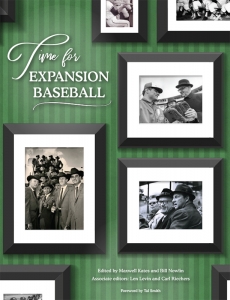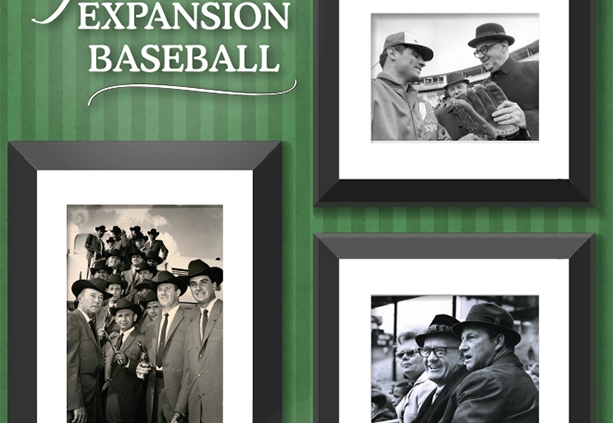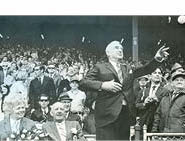Expansion, Round Two: How Charlie Finley Blew Up Baseball
This article was written by Warren Corbett
This article was published in Time For Expansion Baseball (2018)
 The cartel that ruled the national pastime was called Organized Baseball, but its second round of expansion in 1969 turned into a model of disorganization. The American and National Leagues could not agree on whether, when, or how to expand. The result was a radical restructuring of both leagues that abolished the traditional pennant races.
The cartel that ruled the national pastime was called Organized Baseball, but its second round of expansion in 1969 turned into a model of disorganization. The American and National Leagues could not agree on whether, when, or how to expand. The result was a radical restructuring of both leagues that abolished the traditional pennant races.
The turmoil was Charlie Finley’s fault. Who else?
Almost from the moment the multimillionaire insurance salesman bought the Kansas City Athletics in 1960, he began agitating to leave town. He courted Dallas-Fort Worth, Louisville, Seattle, Oakland, and possibly Venus and Mars. Other American League owners repeatedly told him to stay put, once threatening to take the franchise away from him.1
In 1967 Finley forced the issue. He refused to sign a new lease on the Kansas City ballpark and announced plans to move to Oakland. He had worn down his fellow owners. They approved the move at a meeting in Chicago on October 18.
To salve the wound, the league promised Kansas City a new franchise as part of an expansion to 12 teams no later than 1971. When AL President Joe Cronin broke the news to Kansas City officials, they erupted. Voters had just authorized construction of a new baseball stadium, but it couldn’t be built without a team to pay rent. Mayor Ilus Davis threatened a lawsuit. Even more ominous, US Senator Stuart Symington of Missouri vowed to sponsor legislation to end baseball’s cherished exemption from antitrust laws.
Faced with a threat to the foundation of his employers’ monopoly, Cronin moved faster than he ever had in his days as a Hall of Fame shortstop. With the clock ticking toward midnight, he rounded up as many owners as possible and called them back into session. He could reportedly find only five of the 10; the others had gone out on the town or gone home. Before the sun rose, Cronin announced that the league would expand in 1969, with teams in Kansas City and Seattle.
It was 1960 all over again, one league charging helter-skelter into expansion without consulting the other. For the AL, it was payback; in 1960 the Nationals had struck first to grab the booming Houston market. This time both leagues had eyes on Seattle and the untapped Pacific Northwest. NL President Warren Giles thought the leagues had agreed to work together, and Commissioner William Eckert had appointed a committee to plan an orderly expansion at some future date. Instead, the American League sowed disorder.
Putting the Athletics in Oakland was a mortal danger to the NL’s San Francisco franchise. “It’s a question of whether we can both survive,” Giants owner Horace Stoneham said.2 (His team did, but he didn’t. Stoneham went broke and was forced to sell in 1975.)
What would the National League do? “We don’t want to go off half-cocked,” Giles cautioned.3 The chairman of the NL expansion committee and the most powerful voice in league councils, Walter O’Malley of the Dodgers, said, “I feel if we must expand we have to do it now.”4 But the owners were divided, and expansion required a unanimous vote.
A 12-team American League and a 10-team National League was an unworkable combination. The AL would get two more slices of network television money and two more picks in the amateur draft. The AL planned to split into two divisions, cutting the regular season to 156 games with a playoff series to determine its representative in the World Series. The playoff would steal the spotlight from the final week of the NL pennant race.
The last obstacle to AL expansion fell in February 1968 when Seattle voters approved construction of a new stadium. The National League bowed to the inevitable at a five-hour meeting on April 19. The league would go along with the Americans and add two teams in 1969. Five hopeful cities were preparing bids: Milwaukee, Dallas-Fort Worth, San Diego, Buffalo, and Montreal.
Montreal was by far the largest contender, with a metropolitan population exceeding 2.5 million, but local sportswriter Lloyd McGowan didn’t think much of the city’s chances. It had had no baseball since the Triple-A Royals folded in 1960. “Nowadays Montreal is primarily a hockey, horse racing and football city,” McGowan wrote.5
City officials asked 10 leading businessmen to pledge $1 million each for shares of the team. Charles Bronfman, a 36-year-old heir to the Seagram whiskey empire, anted up. When his wife, Barbara, objected, Bronfman assured her, “Well, it’s never going to happen anyway.”6
Montreal’s mayor thought otherwise. Jean Drapeau, who held the office for 29 years, pursued big dreams and let lesser men sweat the details. He sent a letter to the National League promising to build a domed stadium by 1971. Never mind that the city council had not voted to fund such a project. The mayor had a favorite saying: “There are no problems, only solutions.”7
National League owners met in Chicago on May 27 to decide which cities would win the precious title “major league.” San Diego appeared to be a lock; it had Walter O’Malley’s support, and his longtime general manager, Buzzie Bavasi, was part-owner. The other bidders came with baggage. Montreal is outside the United States and most of its residents speak French. Milwaukee was the biggest US market in the running, but some owners hadn’t forgiven the city for suing baseball when the Braves moved to Atlanta. Dallas-Fort Worth faced a roadblock in Houston’s Judge Roy Hofheinz, who wanted his Astros to be the lone star in Texas. Buffalo’s ballpark was in such a rough neighborhood that the Triple-A club had moved night games to Niagara Falls.8
The meeting slogged on through 16, 17, 18 ballots. A dinner with the commissioner was canceled. At 10:00 P.M. President Giles emerged, his white hair like smoke rising from the Vatican. The anointed: San Diego and Montreal. Bronfman said most of the Montreal owners were “flabbergasted.”9 Mayor Drapeau’s dream dome had made the sale. The national pastime went international.
Missouri State Senator Stuart Symington throws out the first pitch on Opening Day for the Kansas City Royals, April 8, 1969, as Ewing and Muriel Kauffman look onwards. The threat prompted to remove Major League Baseball’s antitrust exemption after the Kansas City A’s moved to Oakland. The legal action prompted the American League to add two new teams, Kansas City and Seattle, in 1969. (Kansas City Royals)
Now the issue was how to operate 12-team leagues. Division play and postseason playoffs were too radical for the tradition-bound National League owners. They argued that the playoffs were a gimmick that would rob the World Series of some of its luster. A five-game playoff was a crapshoot that might produce a World Series between the third- or fourth-best teams in each league. To those objections, the American League had a simple response: Without divisions, who would buy tickets to see a 12th-place team?10
The logical solution would be to split the two leagues into three eight-team circuits. Logic be damned. “How in the world would we ever decide what teams to put in which leagues?” Giles said. “I don’t think we could ever get agreement on that.”11
The two leagues finally did agree to operate under the same rules. The Nationals caved, although the resolution was called a compromise. The NL accepted division play and playoffs. In return, the AL dropped its plan for a 156-game schedule, magnanimously consenting to keep the revenue from six additional games. The 162-game slate would be unbalanced, with 18 games against each division opponent and 12 against each of those in the other division.
One sure thing about the split into divisions: Some teams wouldn’t be happy. The Chicago White Sox, a founding member of the American League, landed unwillingly in the Western Division along with five come-lately cities: Anaheim, Kansas City, Seattle, Oakland, and Minneapolis-St. Paul. No traditional rivals there, and the White Sox’ West Coast night games would last until around midnight Central Time, a TV ratings-killer.
The National League map caused even more teeth-gnashing. The Mets didn’t want to give up games against the Dodgers and Giants, with their nostalgic fans in New York, and had to be persuaded that a coast-to-coast division wouldn’t fly. Houston, Los Angeles, San Francisco, and San Diego were the only natural Western teams. St. Louis and Chicago were closest, but they didn’t want to be stuck with so many late California games. Cincinnati and Atlanta from the Eastern time zone agreed to join the Mostly Western Division, enticed by the additional dates with the Dodgers and Giants.
Like the first expansion in 1960, the chaotic second round showed that the organization of Organized Baseball was obsolete. Baseball still lacked the strong management structure needed to run a large business. The industry faced game-changing challenges: a newly militant players union and declining popularity. The owners and the Players Association signed their first collective-bargaining agreement in 1968, limiting the owners’ absolute power over players. The next spring a Louis Harris poll found that football had surpassed baseball as America’s most popular sport for the first time.12 And the latest expansion franchises would bring more complications.
WARREN CORBETT, a winner of the 2018 McFarland-SABR Baseball Research Award, is the author of The Wizard of Waxahachie and a contributor to SABR’s BioProject.
Notes
1 Mark Armour, “Charlie Finley,” SABR Baseball Biography Project, sabr.org/bioproj/person/6ac2ee2f, accessed February 22, 2018.
2 Bob Stevens, “Giants More Than Slightly Worried at Invasion by Finley,” The Sporting News, November 4, 1967: 32.
3 Jerome Holtzman, “N.L. Owners Unload Weapons, Vote Against a Fight for Seattle,” The Sporting News, November 25, 1967: 30.
4 Shirley Povich, “This Morning,” Washington Post, March 22, 1968: D1.
5 Lloyd McGowan, “Little Chance for N.L. Team in Montreal,” The Sporting News, May 4, 1968: 30.
6 Charles Bronfman with Howard Green, Distilled (New York: HarperCollins, 2017), location 1371.
7 Ibid., location 1363.
8 C.C. Johnson Spink, “We Believe,” The Sporting News, April 6, 1968: 14.
9 Ted Blackman, “Baseball Holds Draft Here in October,” Montreal Gazette, May 29, 1968: 41.
10 Edward Prell, “N.L. Rejects Two-Division Proposal,” Chicago Tribune, May 29, 1968: C1.
11 Dick Kaegel, “Cool It! That’s What Club Brass Will Do in Wake of Big Fuss,” The Sporting News, June 15, 1968: 4.
12 Louis Harris, “Harris Poll: Football Now No. 1 Sport,” Fort Lauderdale (Florida) News, April 23, 1969: 6B.



